In addition to this material.
Step-by-step installation of a ventilated facade of wooden houses
In order for the structure of the facade system to fully meet the requirements of reliability and durability, as well as to perform its functions well, it is necessary to observe a set of specific rules.
- Traditionally, timber 150x150 mm is used for the construction of wooden residential buildings, and in order to maintain a comfortable air temperature in the premises during the winter cold, additional means of thermal insulation should be taken care of. A mineral wool material with a thickness of about 10 cm is used as insulation.It is attached to wooden floors using special dowels.
- Before starting the installation of the thermal insulation layer of the facade structure, you should install the profile crate on the load-bearing walls of the building - this will be the frame for the finishing material. In its niches, a mineral-cotton insulation is subsequently laid.
- The stage following the installation of the lathing and the thermal insulation layer is the fixing of the film, which serves as a membrane that protects against wind and moisture. At the same time, the insulation will be waterproofed from the outside, while moisture evaporation from the walls of the house will be removed without hindrance.
- The final step in arranging a wooden ventilated facade is cladding. For decoration, it is also desirable to use wood materials, most often a block house is used. The choice of finishing quality is determined by its cost, performance and appearance. Natural wood will not disturb the harmony of the entire construction object.
The cladding material is fixed mechanically (using self-tapping screws, clamps or other means), taking into account the thickness of the ventilation gap.

The main functions of external finishing are decorative and protective. Along with the attractiveness of the exterior of the house, protection of the layers of the facade from adverse weather conditions will be provided.
Moisture evaporating from wooden load-bearing wallsaccumulating from the inside on the surface of the facing material will be able to be freely removed thanks to the existing ventilation system: the air currents moving between the thermal insulation layer and the finish will remove condensation and excess moisture. Thus, the insulation will not get wet and will retain its thermal insulation properties for a long time.
Read also the article about on our website.
You can learn more about the stages of installing a ventilated timber facade by looking at the step-by-step video instructions.
Mounting attachments wooden facade on the example of planken
What are the wooden ventilated facades?
Types of structures of facade systems
Wood ventilated facades are divided into two types, different in structure and function.

1. Complete ventilation system with insulation.
The main tasks of such a system are not only to protect the building from weather conditions and preserve favorable moisture permeability conditions, but also to increase the level of the building's thermal insulation properties. The use of this type of ventilated facade is common in areas with a harsh climate, where the period of cold weather significantly exceeds the duration of the warm season.
2. Lightweight ventilation system.

A feature of this type of wooden ventilated facade is the absence of a layer of thermal insulation, in connection with which the main function of the structure is to control the moisture level of the building. The use of a lightweight ventilated system is justified in southern regions with a mild climate, where positive air temperatures prevail, so there is no point in insulating the building.
The design of a lightweight ventilated facade provides only for the presence of a thin frame system that does not have outlets and finishing material. Various materials can be used as cladding: Block House, siding, lining. Installation of the system is simple, even an inexperienced builder can handle it.
Types of wood trim for ventilated facades
In addition to the previously mentioned materials, other types of wood can be used for facade cladding.

- Thermowood - lightweight lumber (almost half the weight of untreated wood), characterized by ease of processing, reliability, and practicality. Thermal wood trim enhances the building's appearance with an attractive decor.
- Larch board (block house, lining) works best in an area with a high level of humidity, since larch does not rot.
- Exotic hardwoods. They are applicable, due to their properties, to strengthen the frame of the facade system and increase the reliability of fasteners. High price finishing materials from exotic woods is compensated by unique decorative properties.
Installation of a wooden ventilated facade is not so difficult to perform, if you act, observing its stages and taking into account all the nuances. The result of the work will be a comfortable and reliable house that will serve the owners for more than a dozen years.
Turnkey siding facade decoration
from 1250 rub. / m 2
Facade finishing wooden house
from 300 rubles / m 2
Finishing of facades of private houses
from 750 rubles / m 2
We offer finishing of the facade of a wooden house at a cost of work from 300 rubles / m 2 (01.11.2014). Choose solutions for every taste and budget. We install ventilated systems, siding, thermal panels or brick walls. Warranty - from 3 years.
Finishing wooden houses various materials
Work technology
We use various technologies for finishing wooden buildings:
- installation of ventilation facades;
- brick cladding;
- paneling;
- painting.
Ventilated facade
The hinged ventilated facade is mounted by craftsmen on a wooden crate. The gap between the main wall and the cladding material is filled with 3/4 of mineral wool. The remaining quarter is left free for arranging a ventilated area, which prevents moisture accumulation under the sheathing.
We manufacture wooden ventilated facades to order. Our engineers will develop a set of drawings in full accordance with your requirements and dimensions of the house.
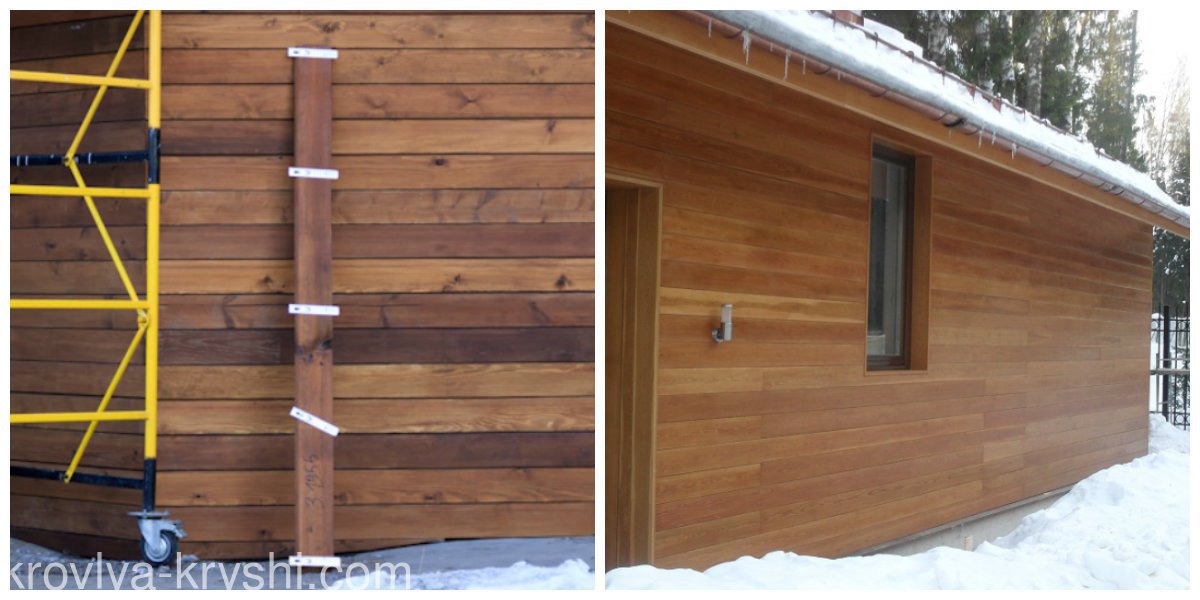 Installation of wooden facades
Installation of wooden facades
Ventilated systems are the best solutions for facades. They are distinguished by resistance to temperature extremes, high thermal insulation and soundproof properties. We install such systems for new and renovated homes.
Facade plastering
Wooden facades are also finished by craftsmen using ordinary plaster. To apply it with high quality, you need to use a reinforcing mesh or stuff wooden slats on the walls. This will prevent the plaster from cracking.
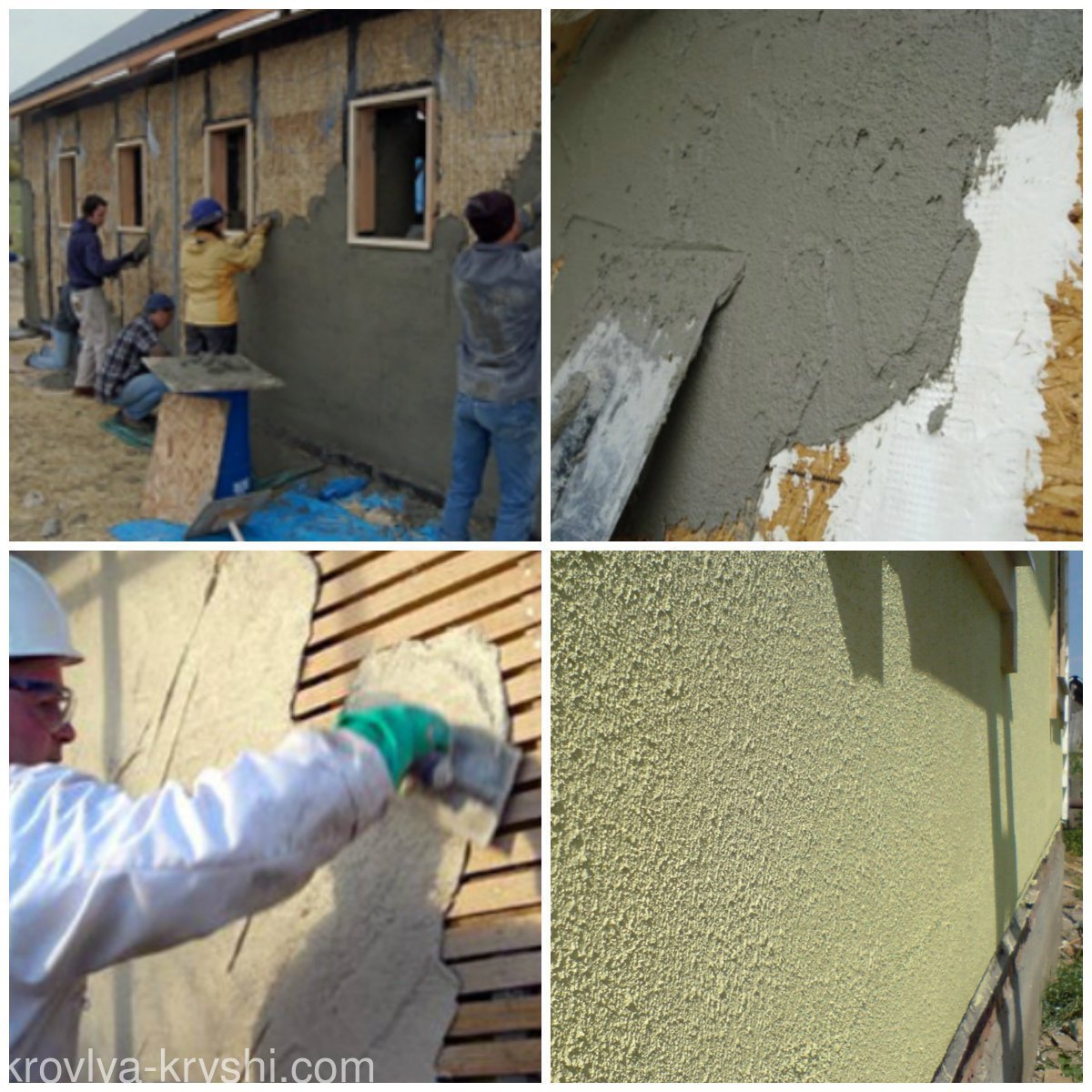 Execution of works
Execution of works
For such works, acrylic plasters are used. They are waterproof and resistant to mechanical damage. In addition, there is a large selection of colors. Mineral plaster is stronger and more durable. But this material is suitable for creating light facades.
Paint or varnish application
It's a classic. Masters process wooden bases protective compounds... First of all, the joints, the edges of the boards and other hard-to-reach places are pre-painted with a narrow beveled brush. After that, they start painting the main part of the facade. Craftsmen perform these works with rollers and wide brushes.
 Painting of wooden houses and cottages
Painting of wooden houses and cottages
All painting work is performed from top to bottom. At the same time, they do not leave drips on the surfaces and do not allow missing areas.
Facing the house with bricks and panels
Brick finishing is performed after the shrinkage and shrinkage of the wooden house. This cladding is resistant to mechanical and atmospheric influences. In addition, it is possible to solve the problem of all wooden buildings - fire safety.
But the big disadvantages of brick cladding are high weight, high cost and laboriousness of finishing. We offer faster, cheaper and more versatile options: installing siding, installing thermal panels. Our craftsmen quickly assemble these facing materials on wooden facades.
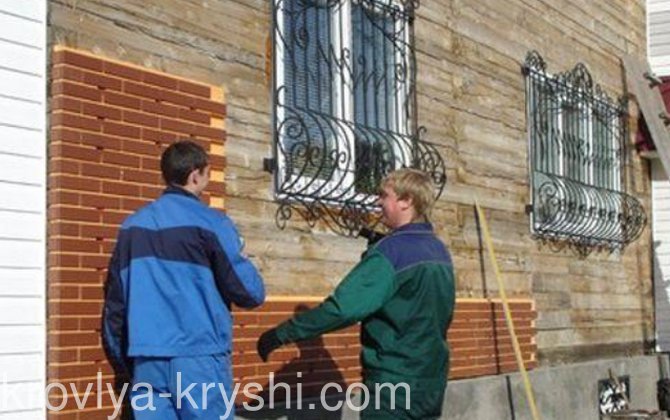 Facing a wooden house with thermal panels
Facing a wooden house with thermal panels
![]() Facing a wooden house with siding
Facing a wooden house with siding
Such finishing does not require additional reinforcement of the building foundation. Siding, although it melts when high temperaturesbut does not burn.
The video analyzes the nuances of finishing wooden objects.
Summary
Even doing such simple jobsas facade decoration wooden structure, requires a professional approach from performers. We guarantee an impeccable appearance of the facade of your house for 3 years. Call and order turnkey work!
Our company carries out cladding of the facade of a wooden house. The cost of finishing is calculated at 250 rubles / m2. You can order the installation of all types of ventilated systems, facade panels and brick cladding from us. Our company is responsible for the quality of work and provides a work warranty for three years. In this article, we suggest you familiarize yourself with several technologies for decorating the walls of wooden houses.
Recently, wooden houses have become very popular. This is not at all surprising, because this is practically the only option for environmentally friendly housing. It should be noted that due to the increase in demand for wooden houses, materials for their cladding have also become in demand. When choosing this or that material, it is worth first determining their purpose and what the finishing functions will be.
What is the decoration of the facade of a wooden house?
The main task of facing a wooden house is to increase the service life of the building without major repairs. There are several types of facade functions:
- A decorative function that the facades of wooden houses have. Is one of the main factors when choosing building materials... Since most people want their building to look neat and beautiful, various types of cladding of a wooden house have been created to help them.
- Protective function. Finishing the facade of a wooden house should protect the walls from rodents, insects and decay. This is especially true of wooden houses, since their material is a bait for small rodents. In addition, weather conditions can negatively affect the condition of the tree, changes in temperature and humidity can lead to rotting of the tree. And prolonged accumulation of moisture will lead to the fact that the walls of the house begin to collapse. Outdoor decoration the facade of a wooden house will provide protection against this. For example, there are a number of special antiseptics that treat wood before use. They need to be applied at regular intervals.
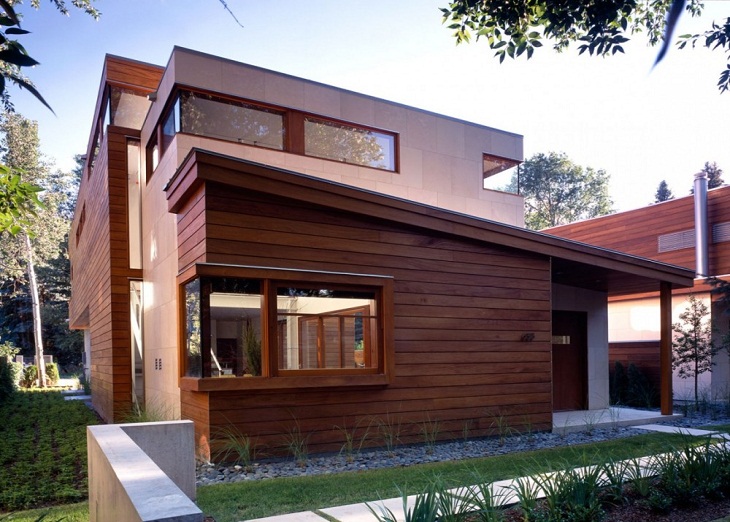

Veneered wooden structures are easy to clean and can be wiped down with a damp cloth. In addition, to the pluses for finishing the facades of buildings, it is worth adding an excellent level of noise, sound and thermal insulation. Your cottage will stay warm in winter and cool in summer.
Modern building materials for facade decoration have non-flammable properties that will protect you from fire.
What materials are used for facade cladding?
The most popular are:
- facades finished with plaster;
- house facade finished brick;
- facade finishedclinker heat panel;
- facade finishedblock house;
- facade finishedsiding.
We will tell you about the pros and cons of each cladding material.
House cladding with plaster
Plaster for wooden houses is not very suitable, you need to resort to it only if no other method can be used. It is impossible to put plaster directly on the beams - it will crumble. Therefore, at first, the walls are crate, that is, they put waterproofing, slats are stuffed on it, or a ready-made crate is installed.
Plaster can be ordinary, or it can be sand-cement mixture... For example, if you want to achieve light color we recommend paying attention to mineral plaster. It is made from plasticizing materials. Acrylic plaster is breathable, adheres well and has a rich palette of shades. However, acrylic plaster does not have such a long service life as mineral plaster. If you want to add originality to your facade of the house, use plaster with crumbs of various minerals.
This type of house cladding is available to almost everyone due to its low cost. Various colors, shades and textures allow you to experiment, embodying the most daring ideas on the facade.
The disadvantages of finishing with cladding a wooden house are changing the appearance of a wooden house, laboriousness and the need for painting.
Facing the house with bricks
Facing bricks, unlike ordinary bricks, have clear geometric shapes, are distinguished by clear, right angles and edges. During installation, the front side should be flawless.
How to clad the facade of a wooden house
The process of facing the facade of a house should begin only after the house has completely shrunk. Since wood is such a material that requires ventilation, the cladding must be installed at a distance of 5 cm from the wall. If, as a material, you have chosen a brick, it should be fixed to the wall using clamps.
It is worth noting that facing bricks should be installed with special attention, because any inaccuracy will be visible and spoil the impression of the house. In addition, the work of finishing with bricks affects the mass of the walls, which gives an even greater load on the foundation. If the building is not initially built with brick cladding, it is better to choose another method. The advantages include fire resistance, a high level of thermal insulation.

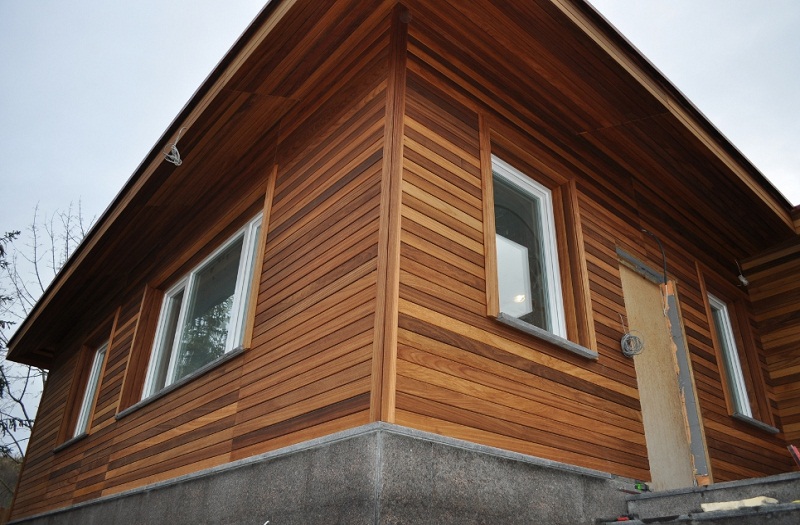
Despite the many advantages of finishing any wooden house, there are also several disadvantages. Firstly, the facade of a wooden house will look different. Now, at first glance, it will not be clear what it is wooden house... Secondly, the mass of the walls and the pressure on the foundation increase.
Facing with clinker heat panels
Clinker heat panels are foamed polyurethane with glued clinker panels. The use of this material will solve two problems at once - thermal insulation.
Such panels have a high level of vapor permeability, increase heat and waterproofing, are lightweight, withstand temperature and humidity changes, are fireproof and are not subject to the influence of various acids and alkalis. In addition, such panels can be installed independently. A wide range of colors can be a plus.
Cladding Block House
Block house is a special material widely used in decoration of such a facade of a wooden house. It is ideal if you want to maintain the appearance of your home. This material is an imitation of a cylindrical log, although the inside is perfectly flat. The block house is installed using a special thorn-groove system, which is located at the end of the panels.
These are panels from natural wood, covered with a special antiseptic against rotting and insect effects. In addition, the plus of this material is that the installation installation is essentially simple.
The disadvantages include the high price, after a while the panels must be reinstalled.
House cladding with siding
Siding is a panel made of polyvinyl chloride (vinyl). The thickness of this material is approximately 1-1.3 mm. For those who want to save a little at the finishing stage, this material is suitable. It does not have a large mass, therefore it does not put pressure on the foundation, the speed of installation justifies all the disadvantages.
Domestic siding will cost you much less than its foreign counterpart, although their specifications are approximately equal.
A wide range of colors will allow everyone to choose a color to their liking. In operation, the siding is simple and convenient, it is easy to clean from dust and dirt.
There are several types of facade cladding for wooden houses:
- vertical;
- horizontal.
Vertical method. You can use tiles and plaster together. This method is good if it means finishing the facade of the house with contrasting shades. For example, the corners of a building can be tiled and the walls of houses can be plastered. Stone tiles and siding also look good. As in the previous example, the corners are tiled, and the walls are decorated with siding in a contrasting color.
Horizontal finishing of the facade of the house
The name speaks for itself - the material is laid horizontally on the facade of a wooden house. For example, the plinth can be made darker and the walls lighter. Also, the lower part can be laid out with a stone.
A great option for finishing the facade is a combination of tiles and wood. The lower facades of houses must be lined with stone or brickwork (so that there is no heavy load on the foundation, choose decorative rock). The facade can be laid out with clapboard or block house.



